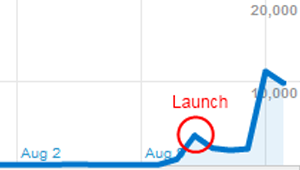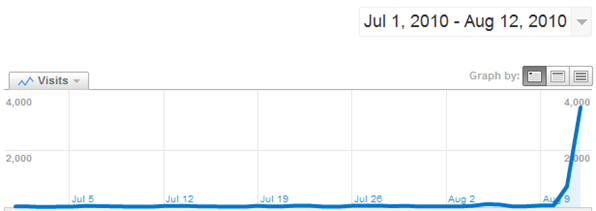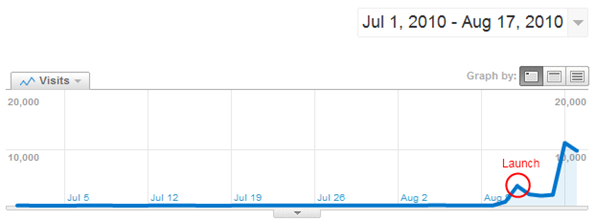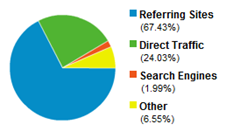We launched Boomerang for Gmail on Wednesday, August 11 at 10:30 PM. After 30 days, we went from a total of 55 downloads to over 70,000. Here’s what happened and some of the lessons we learned.
Timeline:
- Before Launch: 40-50 visits per day, (total: 55 downloads)
- Launch Day (8/11): 3,524 visits
- Friday (8/13): 2048 visits (total: 4,500 downloads)
- Monday (8/16): 11,235 visits (over 8,000 downloads on 8/16)
- Tuesday (8/17): 9,814 visits
- Two Weeks (8/25): (total: 43,000 downloads)
- One Month: 400 organic visits per day (total: 69,500 downloads)
Takeaways:
- Make a product people want, everything else you can fix later.
- Make a video
- Reach out to journalists via Twitter, not email
- Identify scrappy journalists who have covered similar products within 6 months
- Encourage people to tweet about your product as part of the beta program. The people who do will be your best beta users, and the traffic they send will be high quality
- Make an email list. It still works
- Everything we did, except our product, was low-rent. Don’t worry if your website isn’t pretty enough
- Set up a support forum
- Respond to everybody – email, Twitter, blogs, etc.
Other Things to Read:
- TheNextWeb’s coverage of Boomerang
- Udemy’s launch retrospective
- Rapportive’s ‘accidental launch’ post
Full details below.
Thanks to all of our early users, TheNextWeb, all the other folks who picked up on the story, the Baydin team and our interns, and all the passionate users who have helped us spread the word and make Boomerang better. Our launch was amazing mostly because of all of you.
Launch Details
Before we launched, we did some research about what a good launch should look like. We found a fantastic blog post from Udemy about how to launch. In addition to explaining what they did to make their launch successful, the post gave us some context about what a successful launch should look like, so we had a benchmark.
We spent Tuesday and Wednesday reaching out to journalists, and on Wednesday night, we got our first hit. TheNextWeb covered our release with a great post and a killer review. Brad was awesome and worked with us to help make the explanation really solid. We were live.
Our average traffic was about 40-50 visitors per day prior to launch; immediately after, our traffic graph looked like this (10,000 visits, total, through the weekend):
It turns out that Boomerang for Gmail touched a nerve. TheNextWeb’s article was picked up on TechMeme and made it to the front page of Digg. We got additional coverage in Techie-Buzz and Vator.tv.
Our servers melted three different times during the day, in part because we’d spent essentially no time locking down our invitation codes (more below). We intended to release 250 invitation codes on Wednesday night, but we actually had over 4500 installs before we actually managed to improve our invitation code system sometime Thursday. We had so many support requests we could barely respond to them all.
We were thrilled.
We got some inquiries from other blogs on Friday, and we promised 2000 invitation codes to Lifehacker and a few hundred to several others – all of which would run on Monday, after we made our servers tougher. We spent the weekend making improvements to our infrastructure and fixing the most frequent bugs.
Monday afternoon came, all the articles ran. The incredible bump that we saw on Friday? Well, It was a good thing we spent the weekend working on our servers.
Lifehacker’s article alone sent over 15,000 visits. Although we only promised about 3500 invitation codes total to all of the blogs who reached out to us, we kept the invitation codes running until our server load started to become heavy. By the end of Tuesday, we’d let in over 10,000 new users.
A month later, we continue to see roughly 400 new visitors per day – almost a 10x increase in our daily traffic!
If you’re using our experience to plan for scaling up a web service, be careful – Boomerang for Gmail is a downloadable plug-in, so existing users don’t show up in our website traffic at all. They don’t visit our site, they visit Gmail’s. If you’re planning to launch infrastructure for a destination site web service, expect a very different traffic pattern.
Takeaways
We learned a few lessons from our launch that we wish we’d known earlier. Here are a few of our thoughts.
Social Media Works
We had incredible success reaching out over social media. On the Boomerang for Gmail page, we offered our visitors a choice. They could enter an email address to get invited into the beta, or they could tweet that they wanted to receive an invitation code and get invited within 24 hours. Thousands of people chose to tweet. We were able to drive a lot of traffic – converting to over 4500 installs – through Twitter.
This also helped us identify the people were who were going to be most helpful early users and get them early access to the beta. That’s probably part of why we received so much great feedback.
In retrospect, we would have changed the wording of our tweet from:
“I want a beta invitation to Boomerang for Gmail from @baydinsoftware. http://bit.ly/b4gmail”
to something that explains more of what we do. Now that our suggested tweet is:
“I want to schedule when I send and receive emails in Gmail! http://bit.ly/b4gmail Hey @baydinsoftware, send me a Boomerang invite?”
we are seeing better click-through. But there’s a lot less traffic now than during the peak of our launch! Use something like bit.ly to track your click rates, and iterate.
Reaching out to Journalists
When reaching out to journalists, we had our best success using Twitter as well. The not-that-helpful conventional wisdom is to create a strong relationship with the journalist over a period of months. That’s great if you have lots of cash in the bank and can wait months to launch.
But it’s easy to at least get some kind of connection with the journalist — exchange tweets a couple of times. It also helps to know which journalists to reach out to. TheNextWeb was a great venue for us, because Zee launched Rapportive. They’re also scrappier and hungrier than some more brand-name blogs, so they’re more responsive to startups that aren’t already well known.
We posted a form where people could enter an e-mail address in order to be invited into our beta. Those e-mails are the 6.55% “Other” category in the traffic graph on the left. However, they drive about 20% of our traffic today, thanks to our users forwarding and sharing them. The quality of traffic from the e-mail list was also incredible. Our open rates were north of 85%, and virtually nobody unsubscribed, giving us an easy way to communicate and get feedback from our users.
Traffic Quality
The quality of traffic from different sources varies widely. All of our traffic during launch week averaged a 34% bounce rate. Visitors from our email invitations bounced at about 5%. Traffic from Lifehacker bounced at roughly 15%. Those bounce rates are ludicrously low. Getting coverage in publications with a self-selecting audience may be the best bet for getting high quality visitors.
 Invitation Codes – Don’t be a fraidy-cat
Invitation Codes – Don’t be a fraidy-cat
We spent essentially no time locking down our invitation code system. Our version 1 invitation system was a JavaScript redirect to an actual download page. After we had a sufficient number of downloads, we planned to remove the redirect.
Needless to say, this was broken in about five minutes. This was both a blessing and a curse for us. It was a blessing because it helped us get extra visitors and extra beta sign-ups. It helped keep us from having a fraidy-cat launch. It was a curse, because we had no control whatsoever over the downloads the first few days.
It turns out, we had more downloads than we had actual site visitors during our launch week because so many people downloaded the plug-ins from the direct download links.
In retrospect, we probably would not have spent much more time securing our beta system, but JavaScript is not the way to go. On the other hand, we would have been much more aggressive with our beta invitation numbers.
Be Responsive
Being very responsive to our customers helped a lot. We took a lesson from Rapportive’s launch post, and made an effort to respond to every e-mail, every tweet, and every blog post that covered us. I don’t think we got them all, but we did our best. This helped a lot, as we got additional coverage, a dedicated group of users who helped us a lot in our debugging, and some really heartwarming feedback about how awesome Boomerang for Gmail is.
Some of the grouchiest e-mailers ended up being the most helpful, spending an incredible amount of time diving deep to try to figure out what was going wrong.
Our video has probably the worst production quality of any video this side of Star Wars Kid. Posting it may have been the best decision we made.
11,000+ have watched the video to see how Boomerang works. It’s much more clear in the video than it is in text, or even in pictures.
Journalists used our video to show what kind of emails Boomerang would be useful for.
Plus, the only part of our product page that we’re actually proud of is that it had a video on it, which is a HUGE boost to conversion rates.
Plan for engineering to respond to customer requests
We had a lot of plans for what we would build after we launched. They all went out the window after we started receiving real customer feedback. We had hundreds of requests, largely for the same features, and many of the things that our customers were asking for were things that we didn’t realize were important.
As soon as we sprayed our servers down with a fire extinguisher, we got to work on a very quick release of the next build. We added most of the must-have features and fixed most of the major bugs within two weeks.
Use a Support Forum
Set up a support forum before you launch. At first, all we had was a support e-mail address, and we really needed something else. We quickly set up a Vanilla forum (another great TechStars company) to help us consolidate feedback. This saved us a bunch of time responding to support e-mail, and users sharing information with each other solved a lot of problems.
The product was really the key.
We made some great decisions with our launch, largely by luck, and we botched a few things too. But the real reason that our launch went so well is that we had built something that people really wanted. We owe a huge thanks to our 55 initial boomerang users, without whom the 70,000 would never happened. Getting feedback early made a world of difference for us.
Okay, we launched, what now?
One of the big questions we had for our mentors and for some of the other startups that have successful launches is what you do after launching? The major takeaways for us are to:
- Use the momentum from the launch to close a fund-raising round. We’ll have some stories to share later.
- Use the data that the new customers are generating to improve the product and learn about what to do from a business standpoint. We are working on setting up a bunch of great metrics to measure how people are using our product.
- Work on our marketing. We launched with a hideous website, a video that sounds like it was recorded in a men’s room somewhere, a Google Docs form (did you know they really don’t work well after 10,000 entries? we didn’t either!), and a blog where the top post was about an arcane automation and computer vision project at MIT. More proof that the product is really what matters







Great writeup Alex. Keep kickin’ ass!
Great writeup! Thanks for sharing the insight. I was wondering about whether it was best to email or tweet journalists. Did they contact you back with a tweet?
usually, yeah. conversation started over twitter, then followed up via email/phone for the more involved questions.
Great post-launch analysis. very helpful!
Congratulations. Based on your experience, would you say that the invite system helped generate exitcement about the product? Suppose you could handle an infinite amount of users, would you still keep the invite system?
Hard to say, Søren.
It did help generate excitement on Twitter, etc, but I think it also suppressed the total number of users we have now and kept us from getting as much press as we would have gotten if we’d opened it up.
The big help was that everyone who was part of the beta had already self-selected as especially interested and willing to spend a bit of effort to get in. So I think we got a higher quality of early user than we would otherwise have gotten.
If we had the capacity to keep everything running with infinite users, we probably would have done a small, one-week beta to get the high quality feedback, then opened it up.
How does boomerang works? I want to verify it won’t store any of my emails or info on your servers… can you tell please?
Like most other Gmail plugins, we need access to the full email data to be able to move and send messages. In our queries, we only store the headers of the message (subject, sender, time) so that we can uniquely ID the message you want to schedule. We don’t store any message text.
So how do I get access to the support forum?
The support forum is no longer very active since most of our early bugs that impact big chunks of users are fixed. You can email support@baydin.com for any questions you have.